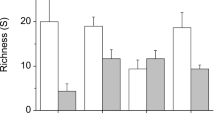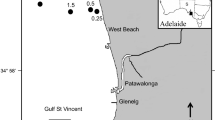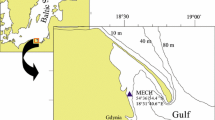Abstract
In northwest Europe, sheltered rocky shores are dominated by fucoid canopy algae and barnacles are rare, although the latter are extremely abundant on exposed shores. The supply of the intertidal barnacle Semibalanus balanoides (L.) to sheltered, fucoid dominated rocky shores was investigated to determine the importance of larval supply in limiting the abundance of adults in shelter. Larval supply was measured at two spatial scales, at the scale of shore (100s of metres), by comparing larval concentrations at exposed and sheltered sites, and at a smaller spatial scale (m), by examining the role of fucoid canopies in limiting supply to the substratum. Replicate plankton trawls were carried out above the intertidal zone at high water at two sheltered sites and nearby exposed headlands. The concentration of S. balanoides cyprid larvae was significantly higher at the sheltered sites on two out of three sampling occasions with up to 14 times greater larvae on one occasion than the nearby exposed site. The effect of the macroalgal canopy on supply to the substratum was assessed in two ways: directly, by pumping water from the substratum in areas with and without Ascophyllum nodosum (L.) Le Jolis, and indirectly by measuring cyprid settlement in a canopy-manipulation experiment. Pumped plankton samples from mid tide level showed that the A. nodosum canopy did not form a barrier to larval supply and may have had a positive effect on larval concentrations at the substratum. Cyprid settlement was assessed in the mid shore A. nodosum and low shore Fucus serratus L. zones to areas with canopy algae (but protected from the sweeping effects of macroalgal fronds) and without canopy. Settlement over three consecutive 24-h periods showed a consistent pattern; settlement was consistently lower beneath the F. serratus canopy than in cleared areas, suggesting that this algal species forms a barrier, limiting supply of cyprid larvae to the substratum.
Similar content being viewed by others
References
Archambault, P. & E. Bourget 1999. Influence of shoreline configuration on spatial variation of meroplanktonic larvae, recruitment and diversity of benthic subtidal communities. J. exp. mar. Biol. Ecol. 238: 161–184.
Archambault, P., J. C. Roff, E. Bourget, B. Bang & G. R. Ingram, 1998. Nearshore abundance of zooplankton in relation to shoreline configuration and mechanisms involved. J. Plankton Res. 20: 671–690.
Bertness, M. D., S. D. Gaines, E. G. Stephens & P. O. Yund, 1992. Components of recruitment in populations of the acorn barnacle Semibalanus balanoides (Linnaeus). J. exp. mar. Biol. Ecol. 156: 199–215.
Bertness, M. D., S. D. Gaines & R. A. Wahle, 1996. Winddriven settlement patterns in the acorn barnacle Semibalanus balanoides. Mar. Ecol. Prog. Ser. 137: 103–110.
Caffey, H. M., 1985. Spatial and temporal variation in settlement and recruitment of intertidal barnacles. Ecol. Monogr. 55: 313–332.
Castilla, J. & M. Varas, 1998. A plankton trap for exposed rocky intertidal shores. Mar. Ecol. Prog. Ser. 175: 299–305.
Deysher, L. & T. A. Norton, 1982. Dispersal and colonisation in Sargassum muticum (Yendo) Fensholt. J. exp. mar. Biol. Ecol. 56: 179–195.
Eckman, J. E., D. O. Duggins & A. T. Sewell, 1989. Ecology of understorey kelp environments. 1. Effects of kelps on flow and particle transport near the bottom. J. exp. mar. Biol. Ecol. 129: 173–187.
Eggleston, D. & D. Armstrong, 1995. Presettlement and postsettlement determinants of estuarine Dungeness crab recruitment. Ecol. Monogr. 65: 193–216.
Fairweather, P. G., 1991. Implications of 'supply-side' ecology for environmental assessment and management. Trends Ecol. Evol. 6: 60–63.
Fischer-Piette, E., 1948. Sur les elements de prosperite des patelles et sur leur specificite. J. Conchyliologie 88: 45–96.
Gaines, S. D., S. Brown & J. Roughgarden, 1985. Spatial variation in larval concentration as a cause of spatial variation in settlement for the barnacle, Balanus glandula. Oecologia 67: 267–272.
Gaines, S. D. & M. D. Bertness, 1992. Dispersal of juveniles and variable recruitment in sessile marine species. Nature 360: 579–580.
Hatton, H., 1938. Essais de bionomie explicative sur quelques especes intercotidales d'algues et d'animaux. Annales de l'Institut Oceanographique 17: 241–348.
Hawkins, S. J. & R. G. Hartnoll. Settlement patterns of Semibalanus balanoides (L.) in the Isle of Man (1977-1981). J. exp. mar. Biol. Ecol. 62: 271–283.
Jenkins, S. R., 1995. The ecology of fucoid canopy dominated shores. PhD, Liverpool.
Jenkins, S. R., T. A. Norton & S. J. Hawkins, 1999a. Settlement and post-settlement interactions between Semibalanus balanoides (L.) (Crustacea: Cirripedia) and three species of fucoid canopy algae. J. exp. mar. Biol. Ecol. 236: 49–67.
Jenkins, S. R., S. J. Hawkins & T. A. Norton, 1999b. Direct and indirect effects of a macroalgal canopy and limpet grazing in structuring a sheltered inter-tidal community. Mar. Ecol. Prog. Ser. 188: 81–92.
Jenkins, S. R., S. J. Hawkins & T. A. Norton 1999c. Interaction between a fucoid canopy and limpet grazing in structuring a low shore intertidal community. J. exp. mar. Biol. Ecol. 233: 41–63.
Leonard, G. H., 1999. Positive and negative effects of intertidal algal canopies on recruitment and survival of barnacles. Mar. Ecol. Prog. Ser. 178: 241–249.
Lewis, J. R., 1964. The Ecology of Rocky Shores. English Universities Press, London.
Lewis, J. R. & R. S. Bowman, 1975. Local habitat induced variations in the population dynamics of Patella vulgata (L). J. exp. mar. Biol. Ecol. 17: 165–203.
McConnaughey, R., D. Armstrong, B. Hickey & D. Gunderson, 1992. Juvenile Dungeness crab (Cancer magister) recruitment variability and oceanic transport during the pelagic larval phase. Can. J. Fish. aquat. Sci. 49: 2028–2044.
McQuaid, C. D. & T. E. Phillips, 2000. Limited wind-driven dispersal of intertidal mussel larvae: in situ evidence from the plankton and the spread of the invasive species Mytilus galloprovincialis in South Africa. Mar. Ecol. Prog. Ser. 201: 211–220.
Minchinton, T. E. & R. E. Scheibling, 1991. The influence of larval supply and settlement on the population structure of barnacles. Ecology 72: 1867–1879.
Miron, G., B. Boudreau & E. Bourget, 1995. The use of larval supply in benthic ecology: testing correlations between larval supply and larval settlement. Mar. Ecol. Prog. Ser. 124: 301–305.
Roughgarden, J., S. Gaines & H. Possingham, 1988. Recruitment dynamics in complex life cycles. Science 241: 1460–1466.
Shanks, A. L., 1986. Tidal periodicity in the daily settlement of intertidal barnacle larvae and an hypothesised mechanism for the cross shelf transport of cyprids. Biol. Bull. 170: 429–440.
Shanks, A. L. & W. G. Wright, 1987. Internal-wave-mediated shoreward transport of cyprids, megalopae, and gammarids and correlated longshore differences in the settling rate of intertidal barnacles. J. exp. mar. Biol. Ecol. 114: 1–13.
Sponaugle, S., R. K. Cowen, A. Shanks, S. G. Morgan, J. M. Leis, J. S. Pineda, G. W. Boehlert, M. J. Kingsford, K. C. Lindeman, C. Grimes & J. L. Munro, 2002. Predicting self-recruitment in marine populations: biophysical correlates and mechanisms. Bull. mar. Sci. 70: 341–375.
Swearer, S. E., J. S. Shima, M. E. Hellberg, S. R. Thorrold, G. P. Jones, D. R. Robertson, S. G. Morgan, K. A. Selkoe, G. M. Ruiz & R.R. Warner, 2002. Evidence of self-recruitment in demersal marine populations. Bull. mar. Sci. 70: 251–271.
Thorson, G., 1950. Reproductive and larval ecology of marine bottom invertebrates. Biol. Rev. 25: 1–45.
Warner, R. R. & R. K. Cowen, 2002. Local retention of production in marine populations: Evidence, mechanisms, and consequences. Bull. mar. Sci. 70: 245–249.
Winer, B. J., 1971. Statistical Principles in Experimental Design. McGraw-Hill Kogakusha, Tokyo.
Yund, P. D., S. D. Gaines & M.D. Bertness, 1991. Cylindrical tube traps for larval sampling. Limnol. Oceanogr. 36: 1167–1177.
Author information
Authors and Affiliations
Rights and permissions
About this article
Cite this article
Jenkins, S., Hawkins, S. Barnacle larval supply to sheltered rocky shores: a limiting factor?. Hydrobiologia 503, 143–151 (2003). https://doi.org/10.1023/B:HYDR.0000008496.68710.22
Issue Date:
DOI: https://doi.org/10.1023/B:HYDR.0000008496.68710.22




